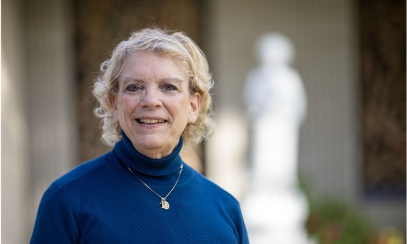
Our Lady of Peace, Fairer Than the Moon
I am writing this on June 15, 2020. It has been ninety-two days since our last public mass. For some it may have seemed like an eternity, for others like the blink of an eye, and yet for others still a little bit of both. How did we get here? Pondering the thought throughout all this, ‘how are we making it through?’ The answer that I have been returning to is, Mary. Let me explain.
In compliance with the request to share this consideration with you, I would like to appeal to an example that we experience so regularly and routinely that we risk taking it for granted: the rising and the setting of the sun.
The sun rises and the sun sets. Big deal, right? Yes.
It is a big deal, especially when the night seems painfully long or the darkness disorientingly black. What really happens at night? Perhaps two significant happenings are the sky turns dark and the moon and stars come out.
The first we can treat with a question. Why is the sky dark? The sun does not cease to shine; the darkened side of the world is standing in the earth’s own shadow, as it were. Although there may be something disquieting about the quiet of the night, there is also a propitious quality about it—something sacred and reverent. Our Lord Himself went out and spent nights in prayer. (cf., Luke 6:12) Saint John of the Cross captures it well in any of the stanzas of his poem titled “The Dark Night.” I choose the second stanza, “In darkness, and secure, by the secret ladder, disguised,--ah, the sheer grace!--in darkness and concealment, my house being now all stilled.”
The second wonder-filled nocturnal event is the appearance of the moon, which brings us to the point of these lines that I write out for you. When the sun sets, the moon comes out –subtle and unassuming –to remind us that the sun still shines. The moon does not possess its own light but shares in the light of the sun. Unlike the sun, our eyes can gaze upon the moon for long periods of time, we are able to absorb the light in a way that is comfortable to our eyes. Of course, it does not provide the clarity and luminance of the sun, but it gives us enough for the moment.
Mary is like the moon. Perhaps we cannot look upon the radiant goodness of her Son, or perhaps like the sun, her Son is not presently visible to us. She remains, she is always here. It seemed to me during these days of sheltering in, at least here at the parish, Mary really stood out. One may say, “This is not so hard to accomplish Father; you have a 32-foot tall stainless-steel statue of Mary. “Standing out” is probably one of her most salient qualities.” Or perhaps the more fitting descriptor is a “Forthright Expression of Faith,” something the holy parish priest who placed her, Monsignor John Sweeny, felt our times needed.
These past days, weeks and months, in our Local Church, the Sun had set. It did not cease to shine, but it had set. For us Catholics, the darkness of night is ever more pronounced in this moment, because we have been deprived of the sunlight that is the Eucharist. The Eucharist is the source and summit of our Christian life: the central axis around which all of the other sacraments’ orbit has been hidden from a great many of God’s people. One could even reasonably suggest that such a setting of the Sun has taken place culturally for some time now.
Just as when the sun is setting and the moon is rising, Mary, like the moon, is assuring us as a mother does so well, “You will be just fine, remain with me for a while. Even if the doors of the Church were locked and the life-giving light of her Son was withdrawn from you, my arms remain open, saying, “Remain here for a time, the Sun will rise again.”
Saint Bernard of Clairvaux looked at her in this way, saying, “You [Mary] are fair as the moon; for just as among all planets the moon is most like the sun, so among all creatures you are the nearest in resemblance to God. The moon illumines the night with the light it receives from the sun, and you enlighten our darkness with the splendor of your virtues. But you are fairer than the moon, for in you there is neither spot nor shadow.”
Returning to the first question: how did we get here? Again, the answer is Mary. And when the darkness of night returns, she will still be there, reminding us that even if the earth should turn its back to the Sun, it never ceases to shine. This is a cause for great peace, a stillness and peace that is sometimes found only through the darkest of nights.

